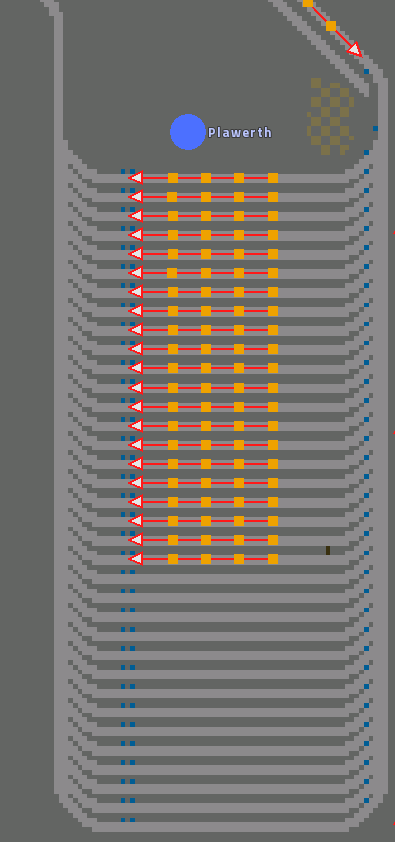Instead it wants drive right through the topmost rail path where a train is already parked.



The problem in your setup is that both entrance and exit in your railyard are from the same side (top) which makes every next parking slot a longer distance. A busy station adds a penatly (a 1000 tiles if I am not mistaken) so when a parking slot is more than a 1000 tiles longer pathfinder will prefer to wait other than going longer way.Plawerth wrote:Is there a limit on the number of rails a train select in a huge rail yard? This huge rail system is failing because the train in the top right does not want to go down to the bottom and pick an open path.
Instead it wants drive right through the topmost rail path where a train is already parked.
Now's the question if the train is supposed to halt at the station OR go through the station without halting.PacifyerGrey wrote:The problem in your setup is that both entrance and exit in your railyard are from the same side (top) which makes every next parking slot a longer distance. A busy station adds a penatly (a 1000 tiles if I am not mistaken) so when a parking slot is more than a 1000 tiles longer pathfinder will prefer to wait other than going longer way.
To fix this issue your parking should have an entrance from bottom right and exit at top left then every parking slot will have almost exact length so every slot will be used.
On the screenshot I did not see any stations in the stacker. This effectively means this is a common chain signal stacker and the distance to the stacker point makes no difference while the total path length for every stacker line means something. In this case my solution will work.MeduSalem wrote:I think Loewchen's approach of making every station equally distanced from the common entrance is a better approach to give each station an equal chance of being chosen... and I think even then it isn't fully guaranteed it won't happen as well when a train for whatever reason doesn't feel like recalculating its path in time when another train before it choses to take the exact same station.
Ah my bad... I thought they are all supposed to be parallel stations and not just a signaled stacker.PacifyerGrey wrote:On the screenshot I did not see any stations in the stacker. This effectively means this is a common chain signal stacker and the distance to the stacker point makes no difference while the total path length for every stacker line means something. In this case my solution will work.
Same here, thought it was stations. In this case, that will work perfectly fine. What I'm wondering is what the stacker is for. Is it train storage? I doubt it's for a station considering the 1 track of input and output would only support a small station, which wouldn't justify this large of a stacker.MeduSalem wrote:Ah my bad... I thought they are all supposed to be parallel stations and not just a signaled stacker.PacifyerGrey wrote:On the screenshot I did not see any stations in the stacker. This effectively means this is a common chain signal stacker and the distance to the stacker point makes no difference while the total path length for every stacker line means something. In this case my solution will work.
Then your solution of placing the exit on the opposite end of the entrace will work of course... because then every parallel track of the stacker would mean equal path length.


You should be able to build it yourself. Just place a stacker blueprint 35 tracks high, and build a couple random stations past that.impetus maximus wrote:i really wanted to see if the first stacker would work if you forced a recalculation. for science.